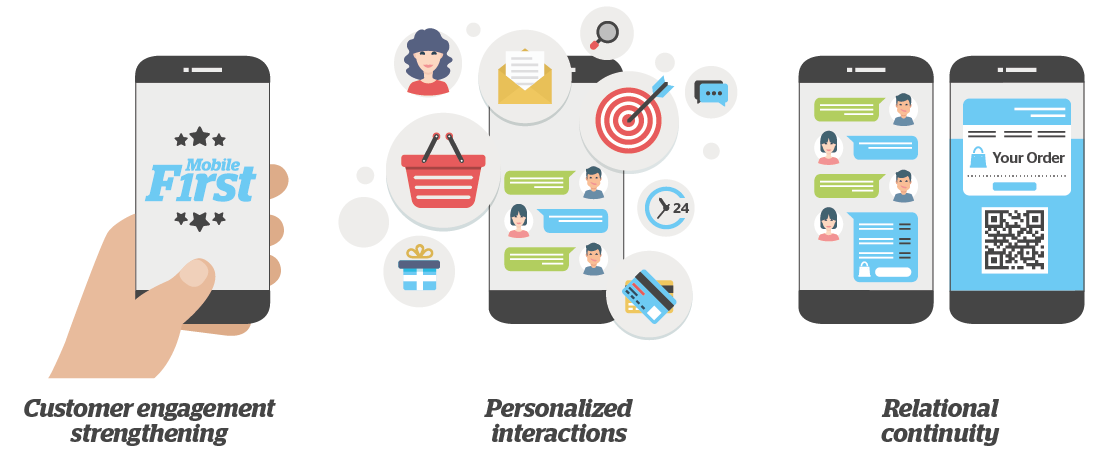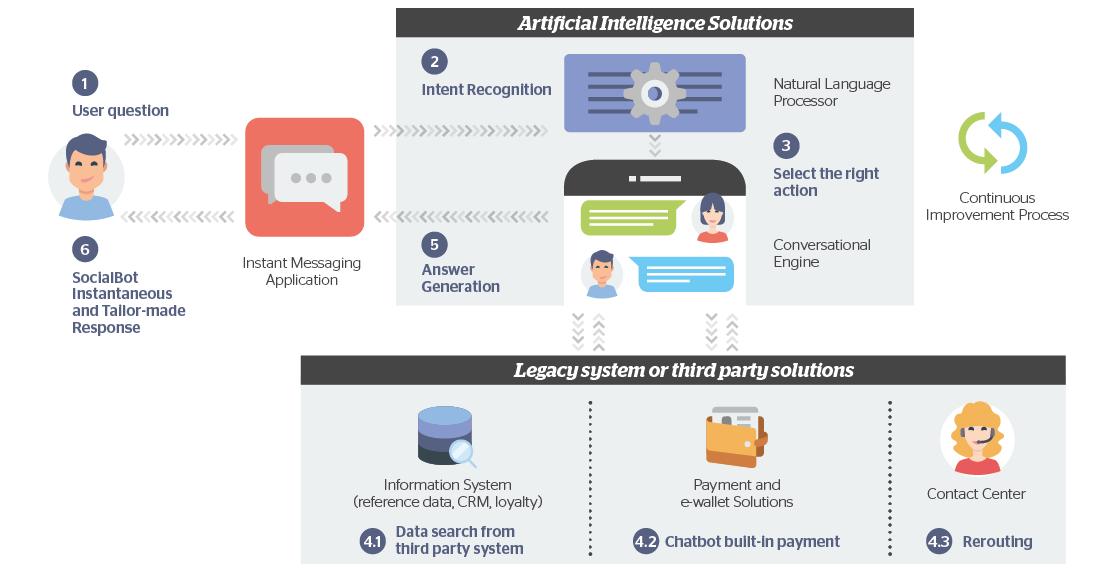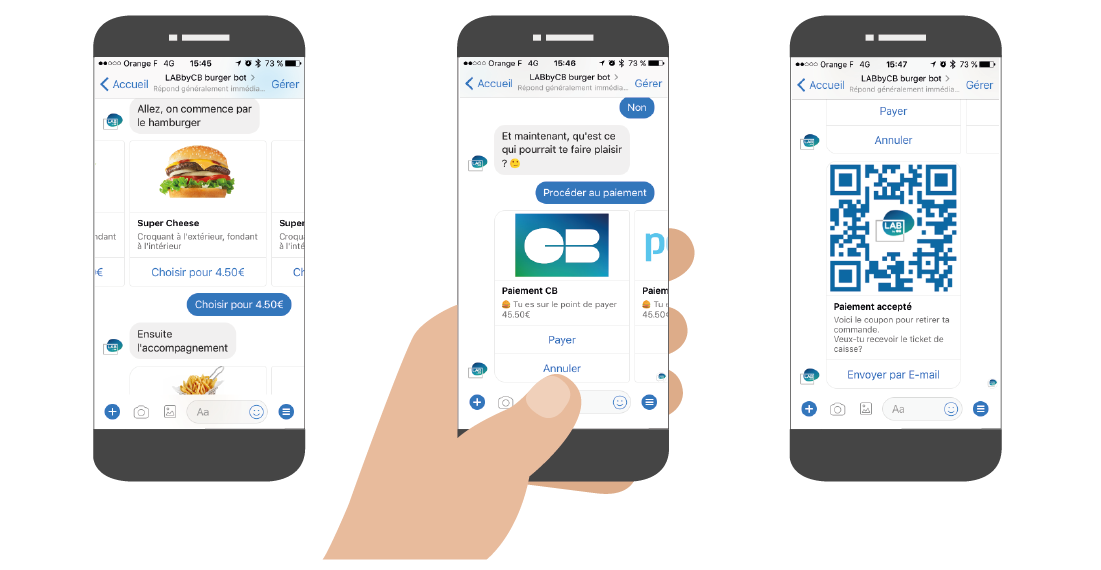Chatbots: from automation to personalisation
16 / 01 / 2018
WeChat, Facebook Messenger, Kik, ... More than half of the 2.5 billion smartphone users around the world use an instant messaging application at least once a day. This new channel is certainly an incredible growth driver for brands. And the opportunity represented by chatbots goes far beyond automating the customer relationship.

Being where your customers are
Chatbots are programs embedded with artificial intelligence that have the ability to simulate a conversation with a human. They have existed for more than 60 years. The subject is not new and this technology can be deployed on various communication media (web front, mobile application, instant messaging application, etc.). So why are chatbots all the rage today?
In fact, the real revolution lies in the instant messaging platforms on which chatbots are being deployed. In early 2016, APIs for the major social platforms were released, accelerating the creation of bots on social networks: the social bots. The enthusiasm of users for instant messaging applications is without a doubt creating a real business opportunity for brands today. The best illustration is the WeChat instant messaging application, used by 600 million people in China on a daily basis. A majority of them use it as a real service platform and may order a taxi, send a bouquet of flowers or pay for their meal directly in the application by registering their payment method. WeChat now enables millions of payment transactions daily. This phenomenon is being closely followed by the online giants (GAFAM: Google, Apple, Facebook, Amazon, Microsoft) and gives us a good indication of the trends that are spreading through these platforms.
Facebook Messenger, with its 1.2 billion users, could establish itself as the preferred platform for accessing mobile services. Indeed, in the United States, it is already possible to order your meal by talking with restaurants who are already on Messenger.

The social bot, your new friend
Instant messaging applications have the advantage of being already installed and used on a daily basis by billions of users. So a brand that wants to launch a specific service on these new platforms will no longer be confronted with the obstacle of downloads. Customers no longer need to download an application; they just need to look for the brand the same way they look up a friend to chat with.
By chatting naturally with the bot as they do with friends, consumers become engaged with every interaction with the brand. Over time, the bot creates a real intimacy with the customer and gets to know them better. This dialogue is conducted in an interface that is consistent across all PC, tablet and mobile channels, where both the context and the chat history can be retained.
By taking advantage of the growing use of conversational interfaces, instant messaging applications are becoming a breeding ground for new interactive services for brands and consumers. Where once we were used to finding applications for our every need on app stores, soon we will be able to find social bots for every service. The opening up of APIs and the creation of a developer community around instant messengers are fostering a rich and dynamic ecosystem, full of promises for the years to come.
Artificial intelligence, a vehicle for stronger customer engagement
Technological progress in the area of artificial intelligence (the science of computer systems that behave like human beings) is another important factor that explains the developing interest in social bots. The processing and generation of natural language are artificial intelligence fields that are now able to offer a very attractive quality of service.
Acquisitions of promising start-up companies in the field of natural language, such as API.AI by Google or WIT.AI by Facebook, demonstrate the interest of GAFAM in these technologies.
Nevertheless, and despite the technological possibilities, it seems that assisted learning is currently preferred over machine learning for social bots. In other words, the bot does not learn completely by itself; human intervention is needed to help the bot identify what is an error and what is not.

"The social bot is becoming an active sales channel for the brand, complementary to a showcase website, a mobile app and a customer relationship centre."
Use case
Social bots have specific characteristics related to instantaneity and availability. They are helpful and free. They can cover a multitude of use cases ranging from customer service to conversational commerce.
A welcoming customer service: "Do little but do it well"
The social bot that can answer all questions on all topics does not exist yet, and may not make sense for a brand! It is better for the proposed service to be defined and explicit for the user, rather than generalist and frustrating.
Social bots can be seen as a new uninterrupted customer relations channel that is free from time constraints and wait times.
These natural dialogues with robots will allow brands to:
- be more available for the customer
- reinforce customer intimacy
- refine their customer knowledge
Humans will not be replaced by these kinds of solutions. We must see the social bot as a complementary tool. The bot greets the user in a friendly and personalized way. It is the first level of the customer relationship that is automated. There is then a fluid and seamless relay to a human agent for value-added tasks.
An interface adapted to the Internet of Things
"There's an app for that" – Steve Jobs
Steve Jobs was right! There are now more than 4 million apps in the Apple and Android stores. There has been an explosion in the number of connected objects – and with each new connected object comes a new application! This is not sustainable given that there are increasingly fewer downloads of new applications. So the ability to consolidate these companion services for connected objects within messaging platforms is an attractive option. We will soon be able to say: "There is a chat for that!"
A new active sales channel: "Pay@Bot"
In some cases, the social bot can be seen as a new active sales channel for brands. How? By incorporating payment into the buying experience in a fully integrated way, so as to boost online sales orders. Two payment flows are possible: A WebView built into the messaging application or an app-to-app payment application to a digital wallet already installed on the user's smartphone.
The brands want support for increasingly more advanced services that include online sales (online fast food orders, see illustration), e-booking (hotels) and connecting with nearby friends (car sharing). This wealth of services will be directly linked to the brands' ability to provide real-time data to the social bot. Clearly, the brands that are able to integrate payment within this new channel first will gain a decisive advantage over their competitors.

"Payment needs to be integrated into the conversation to speed up conversational commerce."
Launching a powerful social bot that will differentiate you from the competition!
To go beyond pre-formatted social bot responses and avoid creating what is in effect an interactive FAQ, it is necessary to integrate the information system into your social bot project. A user could ask "what is my loyalty points balance?" or say "I want to order an XL menu, with a soda and small fries”.
These user questions must first be analyzed and processed by the natural language engine. The role of this engine is to identify intentions. Through this analysis, the conversational engine can identify what action needs to be taken.
In order to formulate the answer, the bot will interact with many information systems (loyalty solution, product reference systems, etc.) and third-party solutions such as payment solutions. It is therefore necessary to coordinate this information in real-time to make it available to the social bot instantly.
Conclusion
Social bots are just another step towards the era of robots. We are seeing a strong trend in the market towards "0 UI" through voice assistants like Amazon's Alexa or Google's Google Home. The conversation is part of an ongoing simplification of the interfaces between the brand and its customers in order to increase customer engagement and boost business.
